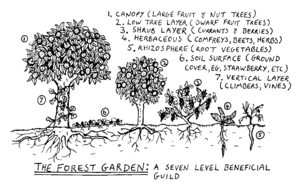Vegetation layers
(Redirected from Layer)
Jump to navigation
Jump to search

There are seven layers to a forest garden.
- This article is about the vertical structure of a forest. For a plant propagation method, see layering.
There are seven recognized vegetation layers to a densely inter-cropped temperate forest gardens, as developed by Robert Hart.
- The canopy: the tallest plants in the ecosystem, generally defined as over 12 feet tall. This layer includes small to very large trees but sometimes can include very large shrubs or tall vines. These plants dominate the forest garden, receive the full strength of the sun, and shade the rest of the forest.[1]
- Understory layer: trees that revel in the dappled light under the canopy.
- Shrub layer: a diverse layer of woody perennials of limited height. includes most berry bushes.
- Herbaceous layer: Plants in this layer die back to the ground every winter (if winters are cold enough, that is). They do not produce woody stems as the Shrub layer does. Many culinary and medicinal herbs are in this layer. A large variety of beneficial plants fall into this layer. May be annuals, biennials or perennials.
- Groundcover: There is some overlap with the Herbaceous layer and the groundcover layer; however plants in this layer grow much closer to the ground, grow densely to fill bare patches of soil, and often can tolerate some foot traffic. Cover crops retain soil and lessen erosion, along with green manures that add nutrients and organic matter to the soil, especially nitrogen.
- Rhizosphere: Root layers within the soil. The major components of this layer are the soil and the organisms that live within it such as plant roots (including root crops such as potatoes and other edible tubers), fungi, insects, nematodes, worms, etc.
- Vertical layer: climbers or vines, such as runner beans and lima beans.
These layers were simplified by Patrick Whitefield to four due to challenges differentiating between layers:
- Trees
- Shrubs
- Vegetables
- Verticals
References
- ↑ Edible Forest Gardens Volume One, page 69